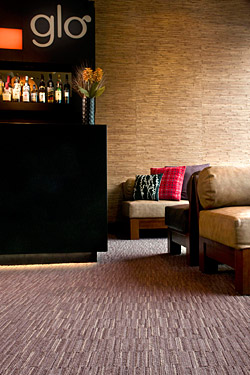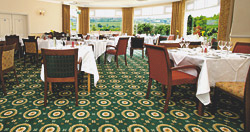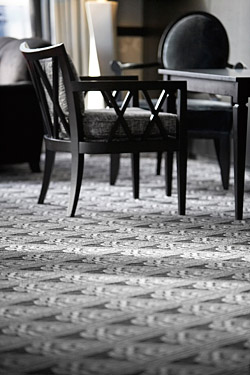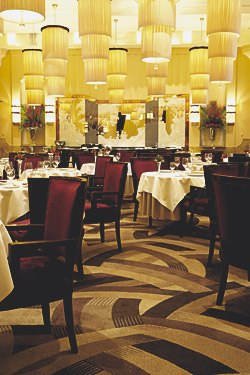home > carpet news > magazine features > Carpet for Hospitality Venues
Carpet for Hospitality Venues
Hard surfaces have certainly played a bigger part in hospitality venues over recent years, gaining in popularity thanks to the fashion for a minimalist approach to floors and interior decor, but as the limitations of these floorcoverings are realised, carpet is once again returning to the fold.
In fact, for many end-users carpet has never left the fold, with its design flexibility and ability to improve user comfort making it an obvious and necessary choice. With this in mind, we take a look at how carpet can work for your space, both in terms of the design of your interior and the practical aspects of using carpet within hospitality interiors.
As a design element, the scope offered by carpet is quite literally endless, with the variables of texture, colour and pattern combining to offer countless permeations of a theme, numerous unique interpretations and above all a diversity that is far in excess of other floorcoverings.
Manufacturers have strived to create stock products that offer more than just a glimpse of this flexibility and styles range far and wide, from the traditional floral and trellis designs one associates with axminster carpets, to ultra-contemporary styles that fuse texture, colour and pattern in carpets designed to provide inspiration and the basis for striking interiors.
Most carpet manufacturers now rely on in-house design teams to use the latest trend forecasting tools, design libraries and their own creativity to create hospitality-focused carpets, leading to a constant stream of re-worked styles and fresh products that continue to push boundaries.
Of course, the right carpet design is entirely dependant on the vision you or your interior specifier has for the space in question, but suffice to say more often than not, there is a carpet to meet your aspirations.
The role of traditional carpet designs, often drawn from libraries with designs dating back many decades, is still relevant within today's hospitality sector, with many traditional hotels relying on these carpets to provide an air of almost regal elegance. Fortunately, there are plenty of manufacturers still keen to push these traditional woven styles and names such as Brintons and Axminster Carpets are often the first to be suggested. And for good reason, as these manufacturers have built their reputations on producing these styles.
Many carpets for these buildings are based on existing patterns but are adjusted in both colour and design to suit the interior in question. Axminster Carpets Ready to Weave concept exemplifies this approach, delivering "tuned" rather than completely bespoke traditional style carpets. Choosing the preferred pattern, designers can select two groundshades from 10 on offer combining them with up to six highlight colours. The result is a traditional style carpet that meets the exacting needs of the location.
Services such as these are shaping carpet into a uniquely flexible design element and are being seen on all levels, from total bespoke creations to the adaptation of existing portfolios that incorporate both modern and traditional styles. In these situations, a bank of designs can be given an individual twist by selecting colours from a palette.
In the case of Lano Carpets' Walk of Fame II concept, there is the freedom to choose from eight designs, ranging from a floral scroll to a stripe, working with 16 standard colours that can be used throughout the interior. This way, the carpet can vary design while using the same colours, or colour while varying design, without loosing unity and allowing a harmonious transition between areas.
As the largest single surface within any hospitality location, the carpet's impact on the ambience of the location cannot be underestimated and should always reflect the investment in the interior. For those hotels of a high specification nature, the carpet should be a key element of the design reflecting the positioning as a luxurious venue, where individual style is of paramount importance.
Carpet manufacturers are rising to the challenge by introducing ranges that offer a premium level of luxury in their construction, as well as unique designs, designed to work individually or together. The opulence of designs such as Gobelin, from Vorwerk Carpets' Castello collection are typical of these creations, whereby a consistent colour palette is altered through varying designs. Vorwerk created the Castello collection together with renowned textile designer Ulf Moritz and this high-end woven axminster carpet has been created with an international audience in mind.
So with such a wide array of designs on offer and the ability to create totally bespoke designs, carpet is an obvious choice for the design conscious interior, but the advantages of its selection go beyond style, bringing hospitality locations more practical benefits.
Many users already appreciate the unrivalled underfoot comfort that carpet brings to the equation, but it is also important to factor in the floorcovering's inherent ability to combat background noise and improve thermal insulation.
The reduction of sound is undoubtedly the most noticeable of all of carpets advantages and has been the reason many have shifted away from hard floorcoverings in public spaces, returning back to much quieter carpet. When fitted with a good quality underlay, the results are even more impressive - the sound of footfall is virtually eliminated, background conversations absorbed and general noise from the day to day running of a busy hospitality venue is minimised. The obvious result of this is a more pleasing environment for building users.
With carpet in-situ, its ability to stop heat loss through floors is far better than that of hard floorcoverings, so carpet can also go a small way in helping the running costs of buildings to be reduced and certainly provides a temperature increase that can be perceived by users. Once again, the result of this provides a more pleasing environment for building users.
These practical advantages provide an even stronger case for carpet's use, but some have cited maintenance as a cause for concern. In fact, this is nothing more than a common myth as carpet not only helps to trap dirt, but particularly when its carpet of the patterned variety, it helps to disguise soil between cleaning. However, many still claim that carpet stains easily and becomes dirty looking quickly. The answer to this is to ensure that the carpet is fit for purpose and fibre selection is a critical part of this decision.
For the busiest areas such as receptions, bars and restaurants where spillages and dirt are part of the everyday cycle, advanced polyamide (nylon) type 6.6, such as INVISTA's Antron® carpet fibre, is ideal and it can be found in carpets from Christy Carpets, ege, Vorwerk and The Mohawk Group among others. Not only highly durable, in Antron® LumenaTM guise this fibre is solution-dyed meaning that frequent and harsh cleaning presents hardly any risk of fading or colour changing, ensuring that the carpet retains its looks even under heavy use.
So the case for carpet is a strong one and with the positives of design flexibility, underfoot comfort, sound absorption, thermal insulation and ease of maintenance, there seems little reason not to choose carpet in both public areas and the traditional locations of bedrooms. In fact, the unity and luxury that carpet can bring to locations surely makes it the only choice for those looking to create interiors that will provide a pleasing ambience for users.




 Lano Carpets - Claridges
Lano Carpets - Claridges